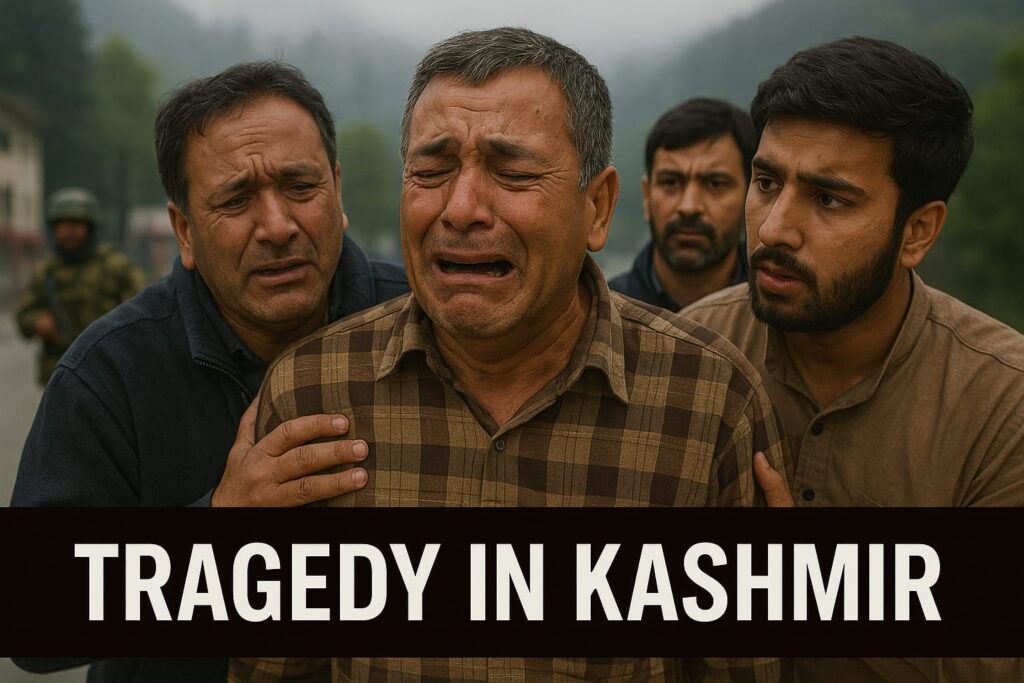
The Pahalgam Massacre and Its Impact on Kashmir
On the serene afternoon of April 22, 2025, the picturesque town of Pahalgam in Jammu and Kashmir was turned into a haunting ground of sorrow and fear. What was supposed to be a peaceful day for tourists enjoying the lush green meadows of Baisaran, just five kilometers from the main town, became one of the darkest chapters in Kashmir’s recent history. Armed militants opened fire on a group of unsuspecting tourists, mercilessly killing 28 people and injuring many more. Among the victims were 24 Indian tourists, two foreign nationals, and two locals, including an officer of the Indian Navy and an official from the Intelligence Bureau. The Resistance Front (TRF), an offshoot of the Pakistan-based Lashkar-e-Taiba, claimed responsibility for the massacre. They cited opposition to alleged demographic changes in the region following the 2019 revocation of Article 370, which had granted special autonomy to Jammu and Kashmir. This act of terror has not only taken innocent lives but also shaken the collective conscience of the nation. The impact has been deeply felt in every corner of Kashmir, where people, regardless of religion or ethnicity, mourn the loss of lives and worry about the return of the dark era.
The Human Cost of Terror
Beyond the numbers and headlines lie the stories of dreams cut short, families destroyed, and trauma that may never fully heal. Children lost their parents. Newlyweds became widows and widowers. Locals who rely on tourism for their livelihood now live in fear, unsure whether their homeland will ever be safe again. Rafiq Ahmad, a local horse guide who witnessed the attack, recounted in tears, “I was leading a group when the gunfire started. I saw people fall… I saw children screaming. I couldn’t do anything. I just ran and prayed. The emotional toll on survivors and witnesses like Rafiq is immeasurable. Hospitals are filled not just with the wounded, but with traumatized souls whose pain cannot be eased with medicine alone.
Why Does This Keep Happening?
Kashmir has been a conflict zone for decades, but over the past few years, there was hope. Hope that the guns would fall silent, that tourists would return, and that the youth would have a future beyond violence. But incidents like the Pahalgam attack reignite old wounds and fears. The motivations behind such acts often stem from political and ideological beliefs manipulated by external and internal forces. Groups like TRF exploit discontent and use violence to push their agendas, usually targeting civilians to create maximum fear and media attention. The revocation of Article 370, while intended as a step toward integration and development, has been a flashpoint for many groups who see it as a threat to Kashmir’s identity.
Impact on Kashmir’s Psyche and Economy
Tourism is the lifeblood of Kashmir’s economy. Pahalgam, Gulmarg, and Sonamarg are not just scenic spots—they are the source of income for thousands of families. Every hotel booking, every taxi ride, every handicraft purchase supports a web of livelihoods. The massacre has caused mass cancellations and panic among future visitors. But more than the economy, the psychological impact is profound. Young Kashmiris who have grown up with stories of conflict are now witnessing it firsthand again. Fear, suspicion, and grief are threatening to undo years of peacebuilding efforts.
How Can We Overcome This?
1. Community Resilience and Unity:
The first step in healing is unity. Kashmiris, both Hindus and Muslims, must continue to show solidarity against such attacks. Civil society must raise its voice, not in anger, but in sorrow and resolve.
2. Mental Health Support:
Psychological trauma must be addressed with urgency. The government and NGOs should set up trauma counseling centers, especially in regions affected by such violence. Healing the mind is as crucial as healing the body.
3. Intelligence and Policing Reforms:
The security apparatus must evolve. More local intelligence, community policing, and trust-building initiatives are needed. Prevention is possible when people trust the police and are willing to share information.
4. Education and Dialogue:
The youth of Kashmir need platforms to express themselves. Schools, colleges, and community centers should focus on peace education, dialogue forums, and awareness about how extremist groups manipulate narratives.
5. International Support and Pressure:
While India must lead its path to peace, the international community should not remain silent. Diplomatic pressure on nations that support or harbor terror groups is essential. At the same time, global humanitarian organizations can play a role in post-traumatic recovery.
6. Reimagining Policy:
Policies regarding Jammu and Kashmir must involve local stakeholders. Development, investment, and integration must go hand in hand with respect for local culture, language, and identity. Without dialogue, distrust grows.
A Call for Peace
The Pahalgam massacre is a grim reminder that peace is fragile and must be guarded with both strength and compassion. As the country mourns the dead, it must also rise to protect the living. Let this not be just another headline that fades with time. Let it be a turning point. For the people of Kashmir, who have long suffered between the crossfires of politics and militancy, the way forward lies in unity, resilience, and hope. Hope that one day, the meadows of Pahalgam will once again echo with laughter, not gunfire. Hope that one day, a child born in Kashmir will not be defined by conflict, but by the promise of peace. We owe it to the victims, to ourselves, and to the generations yet to come.